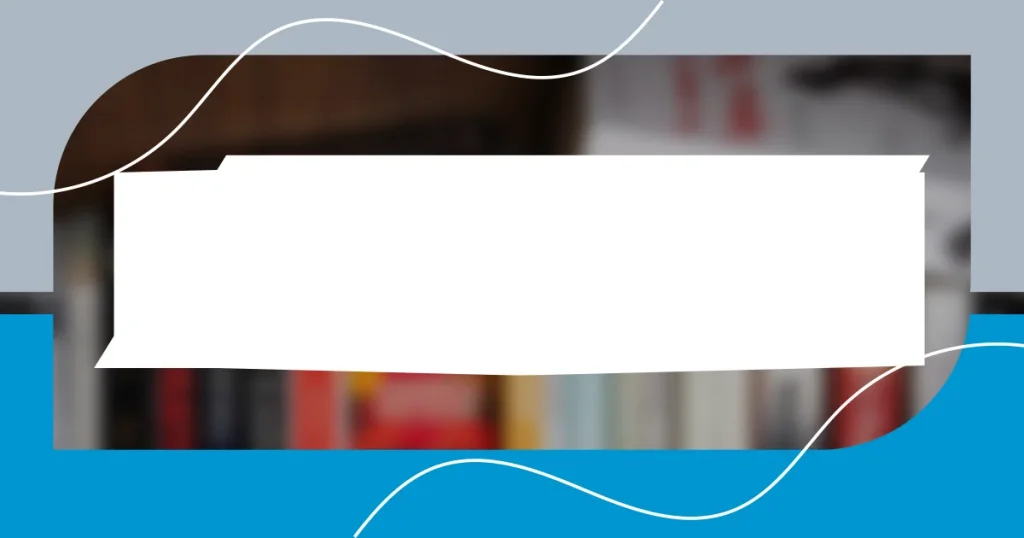Key takeaways:
- Understanding audience reception involves observing non-verbal cues and adapting communication styles for deeper connections.
- Engaging techniques like storytelling, audience interaction, and effective visuals significantly enhance audience involvement and understanding.
- Gathering feedback, both formally and informally, is essential for improving presentations and fostering a culture of continuous growth.

Understanding audience reception
Understanding audience reception goes beyond just knowing your audience. I remember giving a presentation once, and it was clear from the audience’s body language—folded arms, disinterest—that my message wasn’t landing. Have you ever felt that disconnect? It can be disheartening, yet it presents an invaluable opportunity to recalibrate and connect more deeply.
When I think about audience reception, I often reflect on how it directly influences the effectiveness of my communication. I once shared a story about failure that resonated so deeply with my listeners that several approached me afterward to share their experiences. Isn’t it fascinating how a seemingly simple anecdote can bridge gaps and foster connection? This illustrates the need for authenticity; when your audience sees themselves in your narrative, the reception shifts dramatically.
Moreover, understanding the nuances of audience reception often means observing the unspoken cues. There was a time during a workshop when I noticed a slight nod from a participant—a small gesture, but one that said, “I understand.” It made me realize that even subtle reactions can offer profound insights into how my message is being received. Have you ever noticed similar signals? It’s this depth of observation that can truly transform how we engage with our audiences.

Analyzing initial reactions
Analyzing initial reactions is crucial in gauging how effectively I’m communicating. In one instance, I delivered a pitch full of enthusiasm, but the audience sat quietly, their eyes glazed over. It hit me hard at first, but I later realized that their silence wasn’t indifference; it was my responsibility to clarify my message and engage them actively.
- Eye contact can indicate a connection or disinterest.
- Nods may suggest understanding or agreement but could also mean they’re lost in thought.
- Fidgeting or checking phones often reveals boredom or distraction.
- Sudden engagement, like leaning forward, can signal sparks of curiosity.
By taking the time to interpret these reactions, I learned to adapt my style mid-presentation, helping me foster a stronger bond with my audience. It’s a dance of sorts, where both speaker and listener find their rhythm.

Techniques for engaging audiences
Engaging an audience effectively involves using a variety of techniques that resonate with them on different levels. One technique I find invaluable is storytelling. During a recent workshop, I shared a personal failure story about missing a crucial deadline, and to my surprise, the room erupted in laughter. That moment created an immediate bond; I saw people nodding and smiling, connecting with my vulnerability. Isn’t it remarkable how narratives can break down barriers and make a message relatable?
Another approach I embrace is encouraging audience interaction. I once held an open Q&A session after my presentation, and the dialogue that ensued was electrifying. The questions kept coming, and I felt energized by the enthusiasm in the room. It’s fascinating to witness how involving the audience transforms them from passive listeners into active participants. Have you ever tried this technique? It might just change the dynamic of your presentation.
Lastly, utilizing visuals effectively can elevate engagement. I vividly remember a particularly dry topic I was presenting once. To combat the monotony, I incorporated vibrant infographics and compelling images. The shift in energy was palpable; eyes lit up as people engaged with the visuals. It’s a game changer! I believe that when we combine visuals with our verbal messages, we nurture a richer understanding and retention of the material.
| Technique | Description |
|---|---|
| Storytelling | Sharing personal anecdotes to create relatability and connection. |
| Audience Interaction | Encouraging questions and discussions to transform listeners into active participants. |
| Effective Use of Visuals | Incorporating images and infographics to enhance understanding and engagement. |

Gathering feedback effectively
Gathering feedback effectively is one of the most vital steps in improving my presentations. I recall an experience where I handed out feedback forms after a workshop. It was nerve-wracking to ask participants to rate my performance. Yet, the insights I gained were priceless. One attendee noted that my pacing felt rushed, which I later realized hindered their understanding. This taught me the power of structured feedback; it isn’t just about numbers but understanding the narrative behind them.
Another method I’ve found beneficial is holding informal feedback sessions. One time, I invited a small group of peers to discuss a presentation I had delivered. As we chatted over coffee, their candid thoughts poured in; one mentioned they felt overwhelmed by all the information. It struck me that creating a relaxed environment encourages honesty. Have you ever sought feedback in a casual setting? I believe it opens the door to more genuine opinions and collective growth.
Finally, using digital tools for real-time feedback has transformed how I gather insights. During a recent webinar, I implemented a live polling tool where audience members could respond instantly to questions I posed. The results appeared on the screen almost immediately, and I could adjust my content on the fly. This dynamic interaction not only kept them engaged but also empowered them to shape the direction of our discussion. Isn’t it exciting to see how technology can bridge the gap between speaker and audience? It continues to inspire me to refine my approach further.

Adapting to audience responses
When I find myself in front of an audience, their reactions are my compass. For instance, during one presentation, I noticed a few puzzled expressions when I introduced a complex concept. Instead of pushing through, I paused and asked a clarifying question. The relief on their faces was immediate. Adapting my delivery in that moment not only regained their attention, but it also sparked a lively discussion that enriched the session. Can you imagine the difference it makes when you actively respond to the vibe in the room?
In another instance, I was presenting at a conference where the audience seemed unusually quiet. I sensed their disengagement and decided to pivot. I transformed my later slides into a quick storytelling session, drawing them in with a personal experience that tied directly into my topic. The shift was electric; suddenly, audience members were leaning forward, nodding, and even sharing their own stories. It was a beautiful reminder that flexibility is key in engaging an audience. Have you ever felt that rush when the energy in the room changes completely?
I also recall an experience where I sought direct responses from the audience mid-presentation. I asked them to raise their hands if they could relate to a scenario I described. The sight of raised hands brought me such joy! It was a moment of collective acknowledgment and a confirmation that I was on the right track. Adapting to their feedback instantly built a stronger connection. Isn’t it incredible how audience responses can guide us, turning a structured presentation into a dynamic conversation?

Best practices for presentations
When preparing for a presentation, one of the best practices I’ve adopted is to start with a strong opening. I vividly remember a time I opened a workshop with a compelling story rather than jumping into facts and figures. It not only captivated the audience’s attention but also made a personal connection that resonated throughout the session. Have you ever noticed how a story can break the ice and invite listeners into the narrative? It instantly creates a more engaging atmosphere.
Another technique that has brought me success is to use visuals purposefully. During a recent presentation, I incorporated infographics that highlighted key data points visually instead of text-heavy slides. I noticed individuals scribbling notes with genuine interest. The visuals prompted discussions and made it easier for my audience to grasp complex ideas. There’s something powerful about transforming information into a visual format to enhance understanding. How do you think visuals shape your perception of the content presented?
Finally, I believe practice is essential for seamless delivery. Before delivering a major presentation, I often rehearse in front of trusted friends or colleagues. Their feedback on my body language and tone always uncovers aspects I hadn’t considered. For instance, during one rehearsal, a friend observed that I tended to speak too quickly when nervous. Being aware of this helped me slow down my delivery during the actual presentation, allowing my audience to absorb the information more effectively. Isn’t it amazing how a little preparation can lead to such profound improvements?

Evaluating audience impact on content
Evaluating audience impact on content isn’t just a technical process; it’s an emotional and intuitive one. I remember one time during a workshop, I noticed attendees furrowing their brows at a particularly dense part of my material. Their struggle mirrored my own past experiences with overwhelming information, and it made me rethink how I was communicating. Isn’t it fascinating how tuning into their confusion prompted me to rephrase my points, leading to a lightbulb moment for both me and my audience?
I’ve also observed that audience feedback can illuminate the effectiveness of both content and delivery. During a recent talk about innovation, I posed an open-ended question about their experiences. The vibrant discussion that erupted was unlike any scripted interaction. Their stories pulled me in, and I realized that the true value of my presentation lay not just in the content I crafted, but in the shared human experience we created together. How often do we get the chance to really connect in such a meaningful way?
On another occasion, I tried an open feedback session immediately after my presentation. The responses were mixed, and while some highlighted the informative nature of my material, others felt it lacked actionable insights. At first, it stung a bit, but I realized that this critical feedback was a goldmine for future improvement. It reaffirmed my belief that actively seeking audience input not only refines my content but also fosters a culture of transparency and growth. Don’t you think there’s immense worth in taking a moment to listen?
















